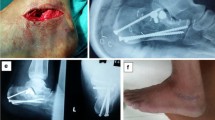Abstract
Objective
Percutaneous reduction by distraction and subsequent percutaneous screw fixation to restore calcaneal and posterior talocalcaneal facet anatomy. The aim of this technique is to improve functional outcome and to diminish the rate of secondary posttraumatic arthrosis compared to conservative treatment and, secondly, to reduce infectious complications compared to open reduction and internal fixation (ORIF).
Indications
Sanders type II–IV displaced intraarticular calcaneal fractures.
Contraindications
Isolated centrally depressed fragment.
Patients who are expected to be noncompliant.
Surgical Technique
Four distractors (Synthes®) are positioned, two on each side of the foot, between the tuberosity of the calcaneus and talus and between the tuberosity and cuboid. A distracting force is given over all four distractors. A blunt drifter is then introduced from the plantar side to unlock and push up any remaining depressed parts of the subtalar joint surface of the calcaneus. The reduction is fixated with two or three screws inserted percutaneously.
Postoperative Management
Directly postoperatively, full active range of motion exercises of the ankle joint can start, with the foot elevated in the 1st postoperative week. Stitches are removed after 14 days. Implant removal is necessary in 50–60% of patients.
Results
Between 1999 and 2004, 59 patients with 71 fractures were treated by percutaneous skeletal triangular distraction and percutaneous fixation. A total of 50 patients with 61 fractures and a minimum follow-up of 1 year were available for follow-up. According to the American Orthopaedic Foot and Ankle Society Hindfoot Score, 72% had a good to excellent result. A secondary subtalar arthrodesis was performed in five patients and planned in four (total 15%). Böhler's angle increased by about 20° postoperatively.
Sagittal motion was 90% and subtalar motion 70% compared to the healthy foot.
Zusammenfassung
Operationsziel
Perkutane Distraktion und anschließende perkutane Schraubenfixierung zur Wiederherstellung der Anatomie der Facetten des Fersenbeins und des hinteren Sprungbeins. Ziele dieser Technik sind eine Verbesserung des funktionalen Ergebnisses und eine Verminderung der Häufigkeitsrate der sekundären posttraumatischen Arthrose im Vergleich zur konservativen Behandlung sowie eine Senkung infektiöser Komplikationen im Vergleich zur offenen Reposition und inneren Fixation (ORIF).
Indikationen
Dislozierte intraartikuläre Kalkaneusfrakturen Typ Sanders II–IV.
Kontraindikationen
Isoliertes, zentrales Depressionsfragment.
Patienten, bei denen mangelnde Mitarbeit zu erwarten ist.
Operationstechnik
Es werden vier Distraktoren (Synthes®) positioniert, zwei auf jeder Seite des Fußes, jeweils zwischen der Tuberositas des Fersenbeins und des Sprungbeins sowie zwischen der Tuberositas und dem Kuboid. Bei allen vier Distraktoren wird Zugkraft eingesetzt. Ein Einschlaginstrument wird dann plantar angesetzt, um die verbleibenden zertrümmerten Teile der subtalaren Gelenkoberfläche des Kalkaneus zu lösen und jegliche verbleibenden Teile heraufzuschieben. Die Reposition wird mit zwei oder drei perkutan eingebrachten Schrauben stabilisiert.
Weiterbehandlung
Unmittelbar postoperativ kann mit Übungen des oberen Sprunggelenks begonnen werden, wobei der Fuß in der 1. Woche hochgelagert wird. Die Fäden werden nach 14 Tagen entfernt. Eine Schraubenentfernung ist bei 50–60% der Patienten erforderlich.
Ergebnisse
Zwischen 1999 und 2004 wurden 59 Patienten mit 71 Frakturen mittels perkutaner dreiseitiger Distraktion und perkutaner Fixation behandelt. Insgesamt 50 Patienten mit 61 Frakturen und einer Mindestnachsorge von 1 Jahr standen bei der Nachuntersuchung zur Verfügung. Laut dem American Orthopaedic Foot and Ankle Society Hindfoot Score wiesen 72% der Patienten ein gutes bis ausgezeichnetes Ergebnis auf. Eine sekundäre subtalare Arthrodese wurde bei fünf Patienten durchgeführt und war bei vier Patienten geplant (insgesamt 15%). Der Böhler-Winkel stieg postoperativ um rund 20°. Im Vergleich zum gesunden Fuß lagen der sagittale Bewegungsumfang bei 90% und der subtalare Bewegungsumfang bei 70%.
Similar content being viewed by others
Author information
Authors and Affiliations
Corresponding author
Rights and permissions
About this article
Cite this article
Schepers, T., Vogels, L.M.M., Schipper, I.B. et al. Percutaneous Reduction and Fixation of Intraarticular Calcaneal Fractures. Oper Orthop Traumatol 20, 168–175 (2008). https://doi.org/10.1007/s00064-008-1239-5
Published:
Issue Date:
DOI: https://doi.org/10.1007/s00064-008-1239-5




